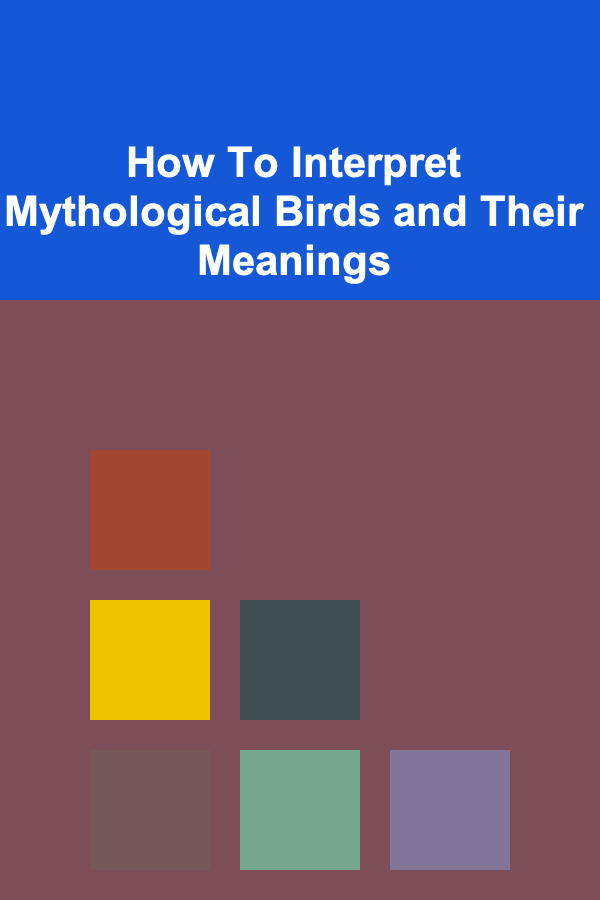
How To Interpret Mythological Birds and Their Meanings
ebook include PDF & Audio bundle (Micro Guide)
$12.99$11.99
Limited Time Offer! Order within the next:

Birds have been a central figure in mythologies around the world, often symbolizing a range of meanings from spiritual messages to earthly powers. In many cultures, birds were seen as intermediaries between the divine and the mortal, messengers of gods, or creatures of transformation. Their flight, songs, and behaviors were believed to carry profound significance, and these meanings have been passed down through countless generations in stories, folklore, and religious texts. This article delves into the deep interpretations of mythological birds, exploring their symbolic meanings and cultural contexts.
The Universal Symbolism of Birds
Birds are one of the most universally recognized symbols across mythologies, appearing in different forms, sizes, and behaviors. They often represent ideas of freedom, spirituality, and transcendence due to their ability to soar through the sky, seemingly free from the constraints of the Earth. Birds, as creatures of flight, represent the connection between heaven and earth, making them potent symbols in mythology.
However, the interpretation of birds goes far beyond this general understanding. Each bird in mythological tales carries specific meanings, often tied to the nature of the bird itself or its role in the story. Mythological birds can symbolize anything from death and rebirth to wisdom, love, and destruction, depending on the culture and context.
The Phoenix: Symbol of Rebirth and Immortality
One of the most famous mythological birds is the Phoenix, a creature known for its fiery nature and its connection to death and rebirth. The Phoenix is commonly associated with fire and is said to die in a blaze of flames, only to rise again from its own ashes. This imagery represents a cyclical process of destruction and regeneration, often interpreted as a metaphor for the eternal cycle of life, death, and rebirth.
In Greek mythology, the Phoenix is linked to the sun, and its rebirth is thought to symbolize the daily rise and fall of the sun. The Phoenix is a powerful symbol of immortality and renewal, suggesting that even in death, there is always the possibility of rebirth and transformation. It has become an enduring symbol of resilience, the ability to overcome adversity, and the promise of new beginnings.
The Roc: The Harbinger of Power and Destruction
In Middle Eastern mythology, particularly in the stories from "One Thousand and One Nights," the Roc (or Rukh) is a giant bird that possesses immense power and strength. Often described as large enough to carry off elephants, the Roc represents immense natural forces and, in some interpretations, a reminder of the unstoppable force of nature.
The Roc is most famously known for its role in the adventures of Sinbad the Sailor, where it appears as a formidable adversary. While the bird itself does not symbolize evil, its overwhelming power represents nature's capacity for destruction. In this way, the Roc can be seen as a symbol of divine retribution or the chaotic forces that can disrupt the balance of the world when angered or disturbed.
In some interpretations, the Roc also represents the potential for growth and success. It is a bird of enormous size, symbolizing the vast potential of human ambition, though it also serves as a cautionary symbol of what can happen if one underestimates nature's raw power.
The Thunderbird: Spiritual Guardian and Protector
The Thunderbird is a prominent figure in many Native American myths, particularly in the cultures of the Pacific Northwest, Plains, and Great Lakes regions. The Thunderbird is often depicted as a giant, supernatural bird capable of creating thunder and lightning with the flap of its wings. This bird is a powerful spirit, often associated with both creation and destruction, serving as a guardian and protector.
In Native American culture, the Thunderbird is not just a symbol of power, but also a representation of divine authority and protection. The bird's connection to storms and lightning signifies its role as an intermediary between the divine and the earthly realms. The Thunderbird's ability to wield the forces of nature gives it dominion over the elements, which can be both a blessing and a punishment, depending on the circumstances. In this sense, the Thunderbird embodies the duality of the natural world --- nurturing and destructive, both a force of good and of danger.
The Swan: Beauty, Love, and Transformation
In various mythologies, the Swan is a symbol of beauty, love, and transformation. In Greek mythology, the swan is often associated with the god Zeus, who transformed into a swan in several stories. Perhaps one of the most well-known swan myths is the story of Leda and the Swan, where Zeus, in the form of a swan, seduces Leda. The swan, in this context, represents the blend of divine beauty and powerful forces of attraction.
In other mythological traditions, the swan symbolizes the theme of transformation. For instance, in Celtic myths, the swan is connected to shape-shifting, where women turn into swans as part of magical transformations. The swan also represents love, as in the myth of the Love of the Swan, where a human and a swan are united through love, overcoming societal boundaries. Swans are also known for their lifelong monogamy, which has led them to become symbols of fidelity and romantic devotion in many cultures.
The Owl: Wisdom and Mystery
The Owl is a bird that holds significant meaning in many mythologies, often representing wisdom, knowledge, and the mysterious realms of the night. In ancient Greece, the owl was closely associated with the goddess Athena, the goddess of wisdom, and was considered her sacred animal. The owl's nocturnal nature and ability to see in the dark made it a symbol of insight and intelligence, capable of perceiving what others could not.
The owl also plays a role in many Native American cultures, where it is often seen as a messenger between the world of the living and the world of the spirits. Its eerie, silent flight and piercing eyes make it a symbol of both knowledge and mystery. The owl's symbolism can vary depending on the context; in some cultures, it is seen as a protector, while in others, it is viewed with suspicion, representing death or misfortune. Nonetheless, the owl remains a universal symbol of the search for knowledge and the mysteries of the unknown.
The Eagle: Power, Vision, and Freedom
The Eagle is one of the most revered birds in mythology, often embodying ideals such as power, vision, and freedom. In many cultures, the eagle is a symbol of strength and dominion. In Roman and Greek mythologies, the eagle was often associated with the gods, particularly Zeus, who was said to have an eagle as his companion and messenger. The eagle represents divine authority, often appearing in stories as a symbol of a god's power and justice.
In Native American cultures, the eagle holds a similar place of honor. It is often viewed as a messenger between the human world and the spirit realm, as it flies at great heights and can see things that are far out of reach. The eagle's keen vision symbolizes clarity, insight, and the ability to perceive hidden truths. The bird's majestic flight is also a symbol of freedom and independence, as it soars without restriction, embodying the human desire for autonomy and transcendence.
The Raven: Trickster and Teacher
The Raven is a complex and multifaceted figure in many mythologies, particularly in Norse and Native American traditions. Often portrayed as a trickster or shape-shifter, the raven is known for its cleverness and wit. In Norse mythology, the god Odin had two ravens, Hugin and Munin, who flew across the world to bring him news. These ravens represented thought and memory, and their presence was integral to Odin's wisdom.
In Native American cultures, particularly those of the Pacific Northwest, the raven is often seen as a creator and teacher, capable of bringing light into the world. The raven's trickster qualities often lead it to play pranks on other gods or creatures, but these pranks are also viewed as teaching moments, where the raven brings forth knowledge through its cunning actions. While the raven's trickster role may cause mischief, it also represents transformation and change, often teaching those who encounter it valuable lessons about life and the world.
Conclusion
The birds of mythology are more than just creatures with wings --- they are symbolic representations of humanity's deepest desires, fears, and aspirations. From the rebirth of the Phoenix to the divine wisdom of the Owl, these mythological birds represent a range of meanings that reflect the complexity of human existence. Whether as messengers of gods, symbols of power, or embodiments of transformation, these birds offer us insight into the nature of life, death, and the mysterious forces that shape our world.
Through the study of mythological birds, we can better understand the cultures that created these stories, as well as the universal themes that connect us all. The power of mythological birds lies in their ability to transcend time and place, offering us timeless lessons on life, freedom, and the interconnectedness of all beings.

How to Manage Your Online Subscriptions Efficiently
Read More
How to Properly Clean and Care for Your Washing Machine
Read More
How to Set Up a Family Puzzle Night for Team Building
Read More
How to Stage a Home to Sell During the Winter Season
Read More
How to Grasp the Concept of Justice
Read More
How to Meal Prep for a Healthy Week: A Comprehensive Guide
Read MoreOther Products

How to Manage Your Online Subscriptions Efficiently
Read More
How to Properly Clean and Care for Your Washing Machine
Read More
How to Set Up a Family Puzzle Night for Team Building
Read More
How to Stage a Home to Sell During the Winter Season
Read More
How to Grasp the Concept of Justice
Read More